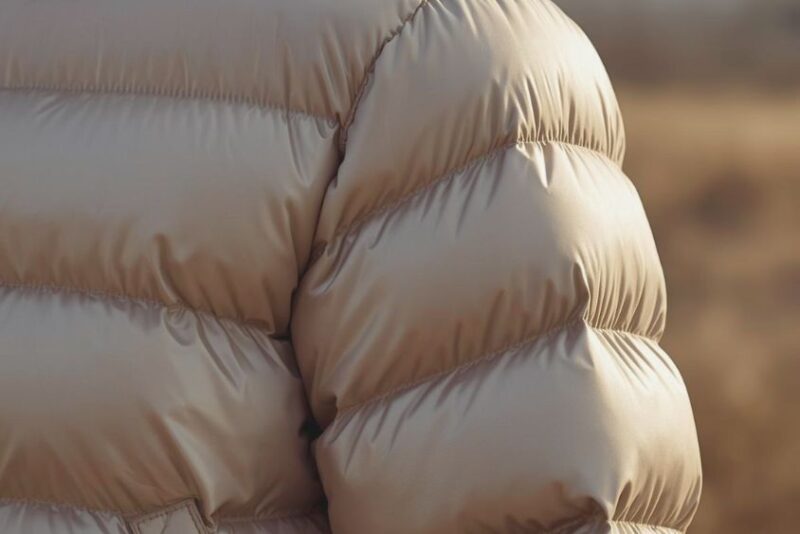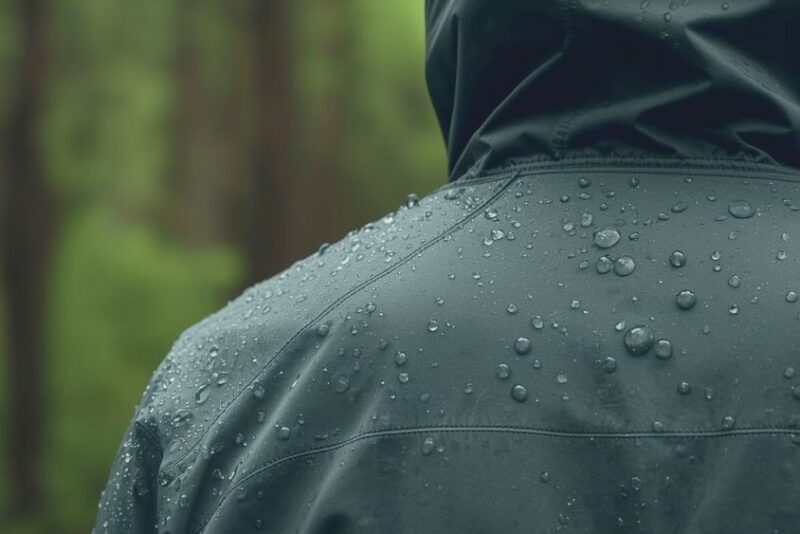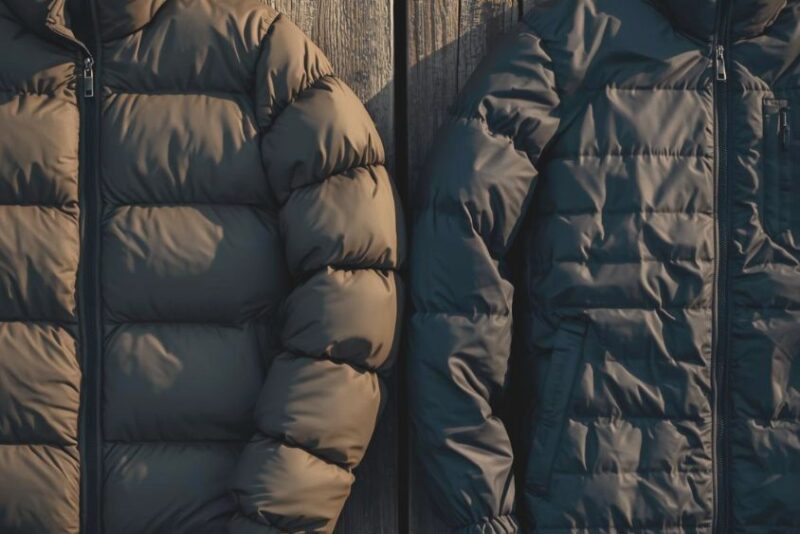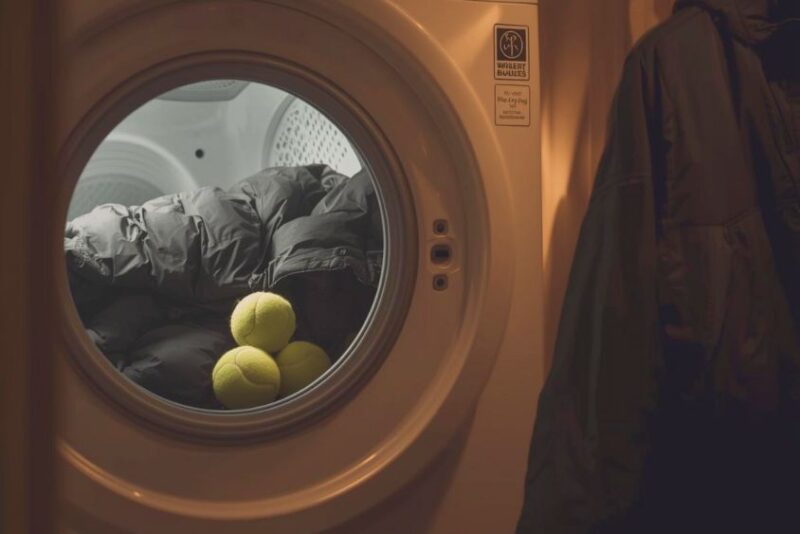Down vs synthetic jacket isn’t just an outdoor geek debate — it’s the reason you either shiver on a wet trail or feel smugly warm while your friends curse their gear choices.
Funny thing is, both sides swear they’re right: down lovers brag about cloud-like warmth, while synthetic fans point to that one soggy hike where feathers failed.
The truth? The science of insulation is weirder, nerdier, and way more useful than most blog posts make it sound. Ready to see how the fluff inside your jacket really works?
Let’s dig in.
How Insulation Works (The Science Made Simple)

At the end of the day, jackets don’t create warmth — you do. What insulation does is trap your body’s heat in tiny air pockets, slowing the escape into the chilly air outside. The more stable, lofty air pockets a jacket can hold, the toastier you’ll be.
Here’s where things get nerdy in a useful way:
- Fill Power: This isn’t some marketing buzzword. It’s an actual lab test that measures how many cubic inches one ounce of down can loft under controlled pressure. Higher fill power standards mean that each feather cluster creates more puff and warmth per gram. (See the IDFL explanation)
- Fill Weight: The sneaky twin. Even the highest fill power won’t keep you warm if the manufacturer only stuffs a few grams into the jacket. Think of fill power as efficiency and fill weight as quantity — you need both to stay cozy.
- Construction: Warmth isn’t just about what’s inside, but how it’s held in place. Down is usually stitched into baffles (sewn-through or the fancier box-baffle construction) to prevent feathers from migrating. Synthetic insulation comes in two flavors: loose clusters that mimic down (and also need quilting) or continuous sheets (like Climashield Apex) that can skip the baffles altogether.
Same physics, different format: the reasons ultralight coats and the best travel blankets feel warm without weighing much come down to loft and trapped air.
And here’s a fun fact: the same principles apply to other cozy gear too — if you’ve ever wondered why the best travel blankets feel warmer without weighing much, it’s the same science of loft and trapped air at work.
So the next time you hear someone brag about their “900-fill jacket,” you’ll know to ask: “Cool… but how much down did they actually put inside?”
3 Types Of Jacket Insulation
Before we start the showdown of down vs synthetic jacket, it helps to know what we’re actually comparing. Not all “puffy stuff” is created equal — some is plucked, some is spun, and some is engineered in labs with names that sound like sci-fi villains.
Down
Down isn’t the outer feathers you see on birds — it’s the fluffy clusters beneath, shaped like little snowflakes. They’re ridiculously good at lofting (aka creating those warm air pockets).
- Goose vs Duck Down: Goose down usually has higher loft potential, which is why you’ll see it in ultralight, high-end jackets. Duck down is more affordable, sometimes with slightly lower fill powers, but still excellent for warmth.
- Hydrophobic Down: Treated with special coatings to resist moisture. It buys you time in damp conditions, but don’t mistake it for waterproof — a soaked down cluster still collapses like wet tissue paper.
Synthetic

Instead of feathers, synthetics use polyester fibers designed to mimic (or sometimes beat) down.
- Staple-Fiber Synthetic: Tiny fiber clusters, quilted into baffles much like down. Think of it as “artificial feathers” that try to replicate loft.
- Continuous-Filament Sheet: Imagine a single fluffy blanket of fibers (like Climashield Apex). Because it’s one piece, it resists clumping and needs fewer stitch lines, which means fewer cold spots.
- Active Synthetic: The cool kid on the block. Materials like Polartec Alpha are intentionally airy, letting hot, sweaty air escape during high-output activity. They’re less about maximum warmth, more about not turning you into a sauna while moving.
Hybrid/Composite Designs
Here’s where gear nerds really geek out: some jackets combine down and synthetic in mapped zones. For example, down in the chest and core (where warmth matters most) and synthetic in shoulders or cuffs (the damp-prone spots). It’s the best of both worlds — at least in theory.
Down Vs. Synthetic: The 13 Real Differences

Time for the real cage match: Down vs synthetic jacket across the factors that actually matter in the wild. Instead of vague pros and cons, here’s how they stack up when you zoom in on the science and everyday experience.
1. Warmth-to-Weight Ratio → Down Wins
Down is still the undisputed champ when it comes to packing the most warmth into the least bulk. High fill power standards (think 800+) let you stay warm without carrying a small pillow on your back. Synthetic can catch up, but only by adding more material (and weight).
2. Packability → Down Wins
Ever seen a down jacket disappear into a grapefruit-sized stuff sack? That’s the magic of feather clusters springing back after being squished. Synthetics, especially the sheet kind, are bulkier and don’t compress quite as neatly.
3. Moisture Resistance & Dry Time → Synthetic Wins
Here’s the big knock against down: once wet, the loft collapses. Even hydrophobic coatings can only delay the inevitable. Synthetic fibers, on the other hand, keep a surprising amount of loft when damp and dry faster — making them a safer bet if your adventures involve backpacking in the rain.
4. Breathability During Exertion → Active Synthetic Wins
Classic puffies (both down and synthetic) trap heat well… sometimes too well. That’s why active insulations like Polartec Alpha or Octa are game changers — they let sweaty air escape so you don’t feel like a baked potato on the move.
5. Loft Retention After Compression → Down (With Care)
Stuff a synthetic jacket into your pack day after day, and its fibers eventually break down, losing loft. Down, by contrast, can bounce back for years — as long as you keep it clean and dry. There are even documented cases of decades-old down gear still going strong after a wash.
6. Temperature Regulation (Stop & Go Activity) → Active Synthetic Wins
If your pace is unpredictable — think snowshoeing, ski touring, or running in cold rain — active synthetic manages the hot-cold rollercoaster better than down. Down excels at “stand still and stay warm,” but it overheats quickly once you move.
7. Durability & Longevity → Down Wins
Down clusters don’t “wear out” the same way synthetic fibers do. Properly stored and washed, down jackets can last decades. Synthetics slowly lose loft as fibers bend, break, and flatten.
8. Cost & Value → Synthetic Wins (Usually)
High-end goose down can feel like it’s priced per feather. Synthetics, especially staple fiber types, are more budget-friendly. Duck down narrows the price gap, but synthetic is still the easier entry point.
9. Care & Maintenance → Tie
Down needs a gentle wash with down-specific detergent and a careful tumble-dry (see [how to wash a down jacket]). Synthetic can be tossed in more casually, but both benefit from occasional DWR reproofing. Different care, same importance.
10. Ethical Sourcing & Animal Welfare → Synthetic Wins
If you’re vegan or uncomfortable with animal-derived products, synthetics are the clear choice. That said, the Responsible Down Standard exists to ensure no live-plucking or force-feeding, giving down buyers a more ethical option.
11. Sustainability & Environment → It Depends
Recycled down is now common, and some synthetics (like PrimaLoft Bio) are designed to biodegrade faster. At the same time, PFAS-free DWR laws in places like California and New York mean both types are moving toward safer water-repellent treatments. It’s a tie with nuance.
12. Allergies & Sensitivity → Synthetic Wins (Slightly)
Well-processed down is generally hypoallergenic, but if you have sensitive skin or asthma triggered by natural fibers, synthetics offer peace of mind.
13. Style & Versatility → Depends on the Jacket
Let’s be real: the “puffy look” is more about the shell fabric and cut than insulation type. Some down jackets are slim and urban-ready, some synthetics look like marshmallow suits, and vice versa. Don’t judge a jacket by its puffiness.
Myth Vs Fact (Highly Link-Worthy Section)
The outdoor world loves myths almost as much as it loves trail mix. Let’s separate a few of the most persistent half-truths you’ll hear whenever down vs. synthetic jacket comes up.
Myth 1: “900-fill is always warmer than 700-fill.”
Fact: Not necessarily. Fill power measures efficiency, not total warmth. A 700-fill jacket with more fill weight can actually be warmer than a lightly stuffed 900-fill piece. Think of it as comparing a spoonful of espresso to a whole mug of drip coffee — potency versus quantity. (Curious? Check out the official [fill power standards].
Myth 2: “Synthetic keeps you warm when soaked.”
Fact: Better phrasing: synthetic stays less useless than down when wet. Yes, fibers retain more loft than soggy feathers, but if you’re drenched, you’ll still feel cold. This is why shell fabric and water-repellent coatings matter just as much as insulation.
Myth 3: “Synthetic jackets don’t need baffles.”
Fact: Many synthetic jackets do use quilting because staple fibers behave like tiny feathers that need holding in place. The exception is sheet-style insulation (like Climashield Apex), which can be laid in as a single piece.
Myth 4: “Down jackets last forever.”
Fact: Only if you care for them. Oils, sweat, and dirt eventually make clusters clump. A good wash and re-dry cycle can bring them back, but neglect them and you’ll cut their lifespan short.
Myth 5: “Hydrophobic down is waterproof.”
Fact: Hydrophobic treatments help clusters resist wetting out, but they don’t make your jacket rainproof. That’s why even the fanciest down puffy should be paired with a proper shell in heavy weather.
Climate And Activity Decision Matrix
So how do you actually choose between down, synthetic, or something in between? Think of it like a nerdy flowchart for your adventures. The right insulation isn’t about brand hype — it’s about climate and how you move.
Dry & Cold (high altitude trekking, winter camping in the Rockies)
Down shines here. Cold air is crisp and dry, so you get maximum loft without worrying about damp clusters. Packability and warmth-to-weight ratio are unbeatable.
Wet & Stop-Start (rainy forests, shoulder-season backpacking in the Pacific Northwest)
Synthetic insulation pulls ahead. It doesn’t collapse as quickly when damp, and it dries faster. If this is your life, start here: backpacking in the rain.
High-Output in the Cold (ski touring, winter trail running, snowshoeing)
Active synthetic like Polartec Alpha is the MVP. It breathes, dumps heat, and avoids that “boil in a bag” feeling when you’re climbing hard but still need insulation.
Mixed Conditions (traveling through different climates, unpredictable weather)
Hybrid jackets make sense. Down in the core for warmth, synthetic in shoulders, hood, or cuffs for moisture tolerance. It’s the insurance policy of insulation.
In short, picture your environment and your activity level as the X and Y axes. Where they cross is your best insulation choice.
Care, Repair, And Longevity

A jacket’s lifespan isn’t just about the insulation inside — it’s about how you treat it. Take care of it, and it will take care of you for years (sometimes decades). Neglect it, and even the priciest jacket can turn into a limp, soggy sponge.
Caring for Down
Down needs a little pampering. Wash it with a down-specific cleaner, not regular detergent, which can strip natural oils and kill loft. After that, tumble-dry it low and slow with clean tennis balls or dryer balls to break up clumps.
If you want step-by-step instructions, see our guide on how to wash a down jacket. For water resistance, treat it with a down-proof DWR product — not a general fabric spray.
Caring for Synthetic
Synthetic jackets are less fussy. A gentle wash with mild detergent usually does the trick, followed by air drying or a short, low tumble. Reproof the outer fabric occasionally with a PFAS-free DWR treatment to keep moisture from beading up instead of soaking in.
Unlike down, synthetic doesn’t need fluffing — but once fibers start to flatten, they rarely bounce back.
Repairability
Both types can be patched with repair tape or small fabric patches. Down leaks look dramatic (feathers everywhere!), but a quick patch seals them up fine. The real trick is prevention: don’t store your jacket crammed into a stuff sack for months, and keep it away from campfire sparks.
Longevity Check
Down can last decades if washed and stored properly — there are vintage sleeping bags still going strong. Synthetic fibers usually have a shorter life, as they slowly break down with repeated compression and heat cycles. If you want “buy it once and keep it forever” potential, down has the edge.
Quick Comparison Table: Down Vs Synthetic Jacket
Sometimes you just want the cheat sheet. Here’s a side-by-side look at how down, synthetic, and active synthetic stack up — with hybrids sitting in the middle ground.
| Criterion | Why It Matters | Down | Synthetic | Active Synthetic | Hybrid |
|---|---|---|---|---|---|
| Warmth-to-weight | Staying warm without hauling bricks | ★★★★★ | ★★★ | ★★ | ★★★★ |
| Packability | How small it stuffs in your pack | ★★★★★ | ★★★ | ★★ | ★★★★ |
| Wet performance | Loft & warmth when damp | ★★ | ★★★★ | ★★★★ | ★★★ |
| Breathability | Comfort while moving | ★★ | ★★★ | ★★★★★ | ★★★ |
| Longevity | How many years has it held the loft | ★★★★★ | ★★★ | ★★★ | ★★★★ |
| Cost/value | Wallet friendliness | ★★ | ★★★★★ | ★★★ | ★★★ |
| Ethics & sustainability | Animal welfare, recycling, PFAS-free DWR | RDS & recycled down | Recycled & biodegradable fibers | Same as synthetic | Mixed sourcing |
| Care needs | Washing, reproofing, storage | Special wash + careful dry | Easier wash, still reproof | Similar to synthetic | Depends on the zone |
(★ = relative strength; more stars = better performance in that category.)
Choosing What’s Right For You
By now, you’ve probably noticed there’s no single “winner” in the down vs. synthetic jacket debate — just better matches for different scenarios. The trick is to match your jacket to your environment and lifestyle.
- Live in a dry, cold climate or plan alpine trips where pack space is precious? Down will give you the most warmth for the least bulk.
- Expect soggy trails, humid forests, or unpredictable shoulder-season storms? Synthetic is the safer companion.
- Do stop-and-go, high-output activities like ski touring or winter running? Active synthetic keeps you from drowning in your own sweat.
- Want one jacket to cover a little of everything? A hybrid design offers a middle ground.
Also consider your values: if animal welfare is non-negotiable, synthetics win. If you love gear that can last decades with proper care, down has the edge. And if sustainability matters most, you can now find both recycled down and recycled synthetics that perform just as well as their “new” counterparts.
In short: don’t ask, “Which is better?” Ask instead, “Where will I use it most, and how do I want it to perform?” That answer will steer you to the right insulation — and make sure you’re smiling instead of shivering on your next adventure.
If you want to see how these principles show up across real designs and constructions, browse our best down jackets (no sales pitch — just structure and specs that make the trade-offs easy to spot).
Conclusion
The debate over down vs synthetic jacket isn’t about declaring a champion — it’s about context. Each insulation type has its strengths and quirks, and understanding them means you can choose gear that actually works for your adventures.
The nerdy truth is that many outdoor enthusiasts eventually own both: a down jacket for cold, dry trips where packability is king, and a synthetic for damp hikes, sweaty climbs, or all-weather reliability. Some even lean on hybrids as their “one jacket fits most” solution.
At the end of the day, the best jacket is the one that keeps you comfortable enough to focus on the experience — not on how cold or clammy you feel. Choose wisely, care for it well, and your insulation will reward you for years of adventures ahead.
